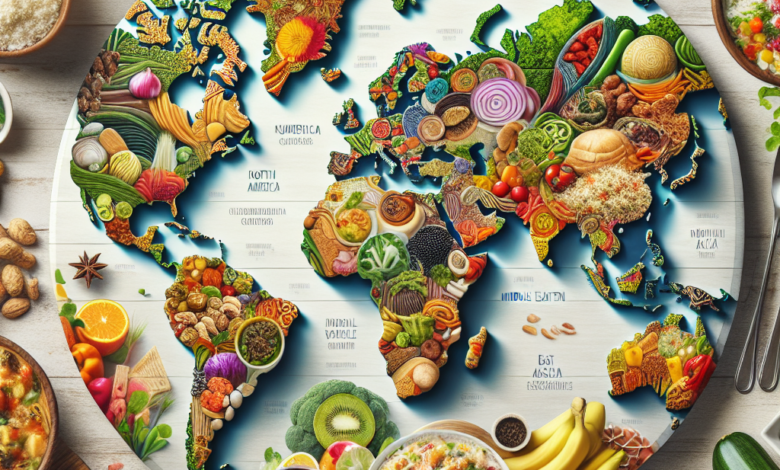Global Vegan: Exploring Plant-Based Cuisines from Around the World

As the world becomes increasingly attuned to the health and environmental benefits of plant-based diets, veganism is experiencing a remarkable surge in popularity. No longer limited to salads and tofu, global vegan cuisine showcases a vibrant tapestry of flavors and traditions from diverse cultures. This journey through plant-based dishes highlights how various regions creatively incorporate local ingredients and culinary techniques to craft delicious meals.
The Roots of Veganism
Veganism has ancient roots, with many cultures embracing plant-based diets long before the modern movement took hold. For instance, Indian religions like Jainism and Buddhism advocate for non-violence and respect for all living beings, promoting vegetarianism for centuries. Similarly, Mediterranean cultures have utilized the healthy and abundant fruits, vegetables, and grains available in their regions, laying the foundation for a variety of traditional vegan dishes.
Asian Inspirations
India
In India, veganism is woven into the fabric of many regional cuisines. Dishes such as Chana Masala (spicy chickpeas) and Baingan Bharta (smoky mashed eggplant) showcase bold spices and vibrant vegetables. Alongside these, the practice of eating "Dal," a lentil-based dish, underscores the protein-rich, plant-driven focus of Indian culinary traditions.
Thailand
Thai cuisine offers an explosion of flavors and aromas, with vegan-friendly options like Pad Thai made with tofu and loaded with fresh vegetables, or Som Tum, a spicy green papaya salad. The extensive use of herbs, such as basil and cilantro, along with coconut milk, adds richness to dishes while keeping them plant-based.
Japan
In Japan, traditional vegan cuisine is celebrated through Shojin Ryori, which emphasizes simple, seasonal ingredients. Dishes often feature tofu, seaweed, and seasonal vegetables, elegantly prepared to maintain their natural flavors. Vegan sushi, utilizing vegetables like cucumber and avocado, has also gained international popularity.
African Flavors
African cuisine encompasses a vast array of flavors, with many regions focusing on staple grains, legumes, and vegetables. In Ethiopia, the communal meal of Injera (a sourdough flatbread) served with various vegetable stews, or Wot, presents an array of mouthwatering plant-based options. The use of spices like berbere enhances the depth of flavors, making these meals vibrant and hearty.
European Delights
Italy
Italy is not just about pasta and cheese; its cuisine features an abundance of plant-based dishes. Pasta Primavera, loaded with seasonal vegetables, and Ribollita, a Tuscan vegetable and bean soup, show how Italian chefs transform simple ingredients into soul-satisfying meals. Vegan pizza, topped with fresh vegetables and plant-based cheese alternatives, has also found a place in the culinary spotlight.
Middle Eastern
Middle Eastern cuisine is a treasure trove of vegan delights. Dishes like Hummus, made from chickpeas and tahini, and Falafel, a deep-fried ball of ground chickpeas, have become global favorites. Tabbouleh, a refreshing salad with parsley, tomatoes, and bulgur wheat, delights with its bright flavors and wholesome ingredients.
The Americas
Latin America
Latin American dishes often emphasize corn, beans, and rice, making them naturally vegan-friendly. Tacos filled with sautéed vegetables or Arepas with avocado and plantains are common staples. The vibrant use of spices and herbs, such as cilantro and lime, brings each dish to life while offering a taste of the region’s rich culinary heritage.
North America
The rise of veganism in North America has inspired a fusion of flavors, blending traditional dishes with innovative plant-based ingredients. From vegan burgers crafted from lentils and quinoa to creative takes on classic comfort foods like mac and cheese made with cashew cream, the continent celebrates plant-based eating in exciting ways.
Challenges and Opportunities
While the global vegan movement is flourishing, challenges remain. Access to fresh, whole foods can be limited in certain regions, and cultural practices might not always align with plant-based diets. Encouraging dialogue about the benefits of global cuisines and their accessibility is crucial in bridging the gap.
Conclusion
Exploring global vegan cuisine offers a delicious journey through cultural traditions and creative culinary practices. As the plant-based movement continues to grow, embracing these diverse flavors can yield not just a more sustainable future but also a richer, more inclusive culinary landscape. Adopting veganism doesn’t mean sacrificing flavor or variety; instead, it presents an opportunity to explore the world, one plate at a time.
